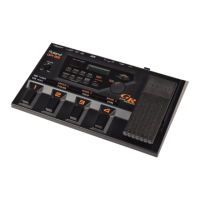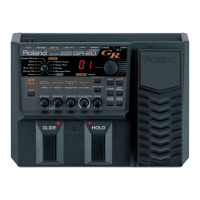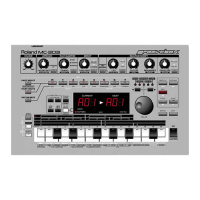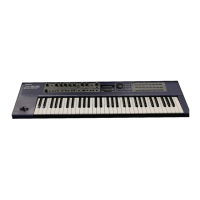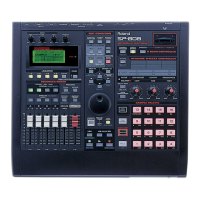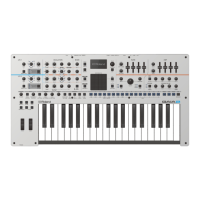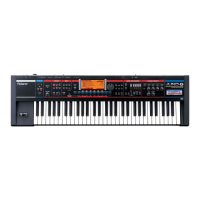bAL (Balance)
Changes the balance of the first and second tones.
With the pedal all the way open (return position),
only the first tone is heard, and when pressed
completely down, only the second tone plays.
bri (Brightness)
Gives continuous change of synth sound bright-
ness.
UAH (Wah)
Resembles a guitar wah-wah pedal, with a lot of
that peculiar sound in the tone change.
Pit (Pitch)
While preserving the structure of a chord, greatly
changes the pitch of the synthesizer’s sound. With
the pedal back, the sound is as usual. The width of
the pitch change follows the change width setting
selected in Pedal Effect mode’s GLIDE TYPE.
(Setting procedure on p. 46.)
Mod (Modulation)
Changes the depth of pitch undulation applied to
the synth sound, from zero to maximum change.
(The speed of the wavering sound depends on the
predetermined setting of the tones selected with
TONE#.)
L-r (Left-Right)
PAN (p. 39) settings in the patch are ignored, and
the placement changes in accordance with the EXP
pedal’s operation. Both first and second tones are
panned right when the pedal is pressed forward,
left when the pedal is brought back.
PAn (Pan/PAN Setting)
Uses the pedal to directly give the effect of chang-
ing the values in a patch’s PAN settings (p. 39) in a
range of -50 to 50. The first tone is panned right
with the pedal pressed forward, and left with the
pedal all the way back. The left tone has opposite
placement.
rE.L (Reverb Level)
Changes reverb level with the EXP pedal. (Does
not affect chorus level.) When the pedal is pressed
forward, the reverb level set in the patch is added;
no effect is added with the pedal all the way back.
tp1 (Tempo Type 1)
Changes arpeggio tempo. When the pedal is
pressed forward, the arpeggio plays at the tempo
set in the patch, and with the pedal all the way
back, the tempo becomes extremely slow.
tp2 (Tempo Type 2)
Changes arpeggio tempo. When the pedal is
pressed forward, the tempo becomes extremely
fast, and with the pedal all the way back, the
tempo returns to that set in the patch.
tp3 (Tempo Type 3)
Adjusts arpeggio tempo in a range of plus or
minus 20% from the center value, the value set in
the patch.
t.n.p. (Tempo and Pitch)
Changes pitch and arpeggio tempo simultaneous-
ly, creating a special effect that resembles the
changing of a tape recorder’s speed. The width of
the pitch change follows the change width setting
selected in Pedal Effect mode’s GLIDE TYPE. (The
setting procedure is on p. 46.)
#1 to #32, #64 to #95,... (MIDI Control
Change)
Sends control change data from MIDI OUT
through the adjustment of the EXP pedal. Select
any numbers from 1 to 32, or from 64 to 95. Use
this when you want to operate external effects or
parameters. Has no effect on internal sound gen-
erators.
✽
When after selecting “L-r” or “PAn” you work the EXP
pedal, you may notice a slight noise, but this does not
indicate any malfunction. Furthermore, this does not
change the placement of reverb or chorus.
✽
You can use the “tP1”, “tP2”, “tP3”, and “t.n.p.” set-
tings when Arpeggiator is on.
✽
“Ad1”, “Ad2”, and “bAL”, are effective if both the first
and second tones are selected with LAYER (p. 34), and
the 1:2 BAL is not assigned to only one of the tones.
✽
When “Pit” or “t.n.p.” is selected, depending on tone
and range, the width of the pitch’s rise may be limited.
✽
The way effect is applied when “bri” or “UAH” is
selected varies according to the selected tone and the
“BRIGHTNESS” setting.
✽
When the minimum volume setting of the EXP pedal is
increased, then the effect will not be completely removed,
even with the EXP pedal all the way back.
50

